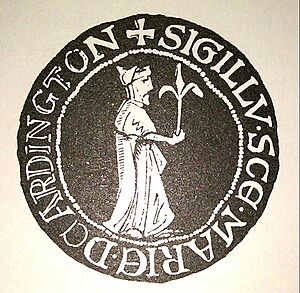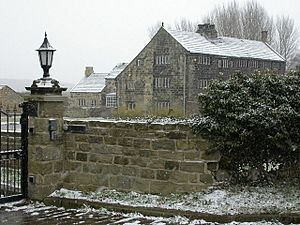Arthington Priory facts for kids
Arthington Priory was a special home for nuns in Arthington, West Yorkshire, England. It was started in the mid-1100s. Today, a house called "Arthington Hall" stands where the priory used to be. This hall was built around 1585. Not much is left of the original priory buildings. A farmhouse called "The Nunnery" might even be built on the old priory church's foundations.
This priory was unique because it was the only home for Cluniac nuns in Yorkshire. It was also one of only two such places in all of England. Peter de Arthington helped start the priory by giving the nuns land.
Contents
How Arthington Priory Started
Peter de Arthington gave the nuns the land where their home was built. His son, Serlo, confirmed this gift and added more land. Later, Serlo's son, also named Peter, confirmed these gifts. He also gave them about 1 acre of land and water rights. This water was for a mill and other important uses.
The priory also received the church at Maltby in South Yorkshire. The Archbishop of York, Alexander Neville, officially gave it to them in 1378. The nuns received other land gifts, but the priory always stayed quite small. Some people gave gifts on one condition: they and their families could send a girl to join the nuns whenever there was an open spot.
Life at the Priory
Records show that life at the priory wasn't always easy. Sometimes, the nuns, and even the prioress (the head nun), needed to follow the rules more strictly.
In 1307, the Archbishop of York, William Greenfield, visited. He wrote to the prioress about four nuns. Two nuns, Dionisia de Heuensdale and Ellen de Castleford, were not allowed to leave the priory grounds. Two others, Agnes de Screvyn and Isabella Couvel, said some priory animals and goods were their own. The prioress made them give these up as punishment.
In 1311, the nuns were told to obey their prioress, Isabella de Berghby. Later, a letter was sent asking someone to find out why Prioress Isabella and another nun, Margaret de Tang, had left. It turned out Isabella was upset about another nun helping manage the priory. She took off her nun's clothes and left. She didn't officially resign, so no new prioress could be chosen until she returned or was removed.
However, in 1312, Maud de Batheley became the new prioress. But then, Isabella de Berghby returned and was forgiven by the archbishop. He told Prioress Maud to let Isabella back in. But Isabella had to take the lowest place among the nuns. She also was not allowed to leave the priory again.
In 1315, Archbishop Greenfield visited again and gave the nuns more rules:
- They had to keep track of all the priory's goods every year.
- Sick nuns needed proper care in the infirmary (sick room).
- Nuns had to be quiet as their rules stated.
- Everyone who could had to attend church services.
- Women who were "lay sisters" (who helped but weren't full nuns) could not wear the special black veil of full nuns.
- No boys or other people not from the priory were allowed to sleep in the nuns' sleeping area.
- When nuns visited family or friends, they could only be gone for 15 days. If they didn't return on time, they would be punished.
- Nuns could only leave the priory once or twice a year.
The archbishop repeated these rules on a later visit.
The Cluniac Order
Arthington Priory followed the rules of the Abbey of Cluny in Burgundy, France. The Cluniac order was a special group of Benedictine monks and nuns. They followed the rules of Saint Benedict very strictly. This helped bring stability to Europe in the 1000s. Cluny became a very important leader in monastic life.
Arthington was one of only two Cluniac nunneries in England. The other was Delapré Abbey in Northampton. The leaders of Cluny were very important people, even on a global stage. The Abbey of Cluny became the biggest and most famous monastery in Europe. The Cluniac order was most powerful from the late 900s to the early 1100s.
The Priory Closes Down
During the time of King Henry VIII, many monasteries in England were closed. This was called the Dissolution of the Monasteries. In 1540, there were nine nuns at Arthington Priory, including the prioress, Elizabeth Hall, who was 45. Records show that all the nuns, including the prioress, were "of good religious living." This means they were good, faithful nuns. Their ages ranged from 25 to 72 years old.
Prioress Elizabeth Hall officially gave up the priory on November 26, 1540. At that time, the priory was worth about £11 8s 4d each year. The land and buildings were valued at £5 8s 4d, and the gardens and orchards were worth 5 shillings a year.
What Happened After the Priory Closed
After the priory closed, King Henry VIII gave the land to Archbishop Thomas Cranmer in 1543. Later, during the time of King Charles I, a large house was built on the priory land. This house is now called Arthington Hall. Its front doorway, dated 1585, might have come from an older building. In 1822, the hall was used as a farmhouse. It belonged to the Earl of Harewood. Old records describe it as "a large well-built, square house, on a fine elevation above the river."
Even though the old priory buildings were gone, records from 1822 still mention "ARTHINGTON NUNNERY." This probably refers to "The Nunnery," a farmhouse. People say this farmhouse stands on the old foundations of the priory church. Its farm buildings might have been built over other parts of the monastery.
Arthington Hall is now a Grade II* listed building, which means it's an important historic building.
The Prioresses of Arthington Priory
Here is a list of the women who were the prioresses (leaders) of Arthington Priory:
- Sara - 1241
- Eleanor - 1299
- Maud de Kesewik - died 1299
- Agnes de Skrevin - 1299-1302 (she resigned)
- Agnes de Pontefract - 1302
- Isabella de Berghby - 1311 (she was demoted after leaving without permission)
- Maud de Batheley - 1312
- Isabella Dautry - died 1349
- Isabella de Berughby - 1349
- Isabel de Eccope - between 1413–20
- Sibil Plesyngton - 1437
- Alice Raucestre - died 1463
- Marjorie Craven - 1463
- Katherine Willesthorp - 1475 (died 1484)
- Alice Mawde - 1484 (died 149)
- Elizabeth Popeley - 1492 (removed from her role in 1494)
- Margaret Turton - 1494 (died 1496)
- Alice Hall - 1496
- Elizabeth Hall - 1532 (she surrendered the Priory in 1540)
In 1543, the property was given to Thomas Cranmer.




